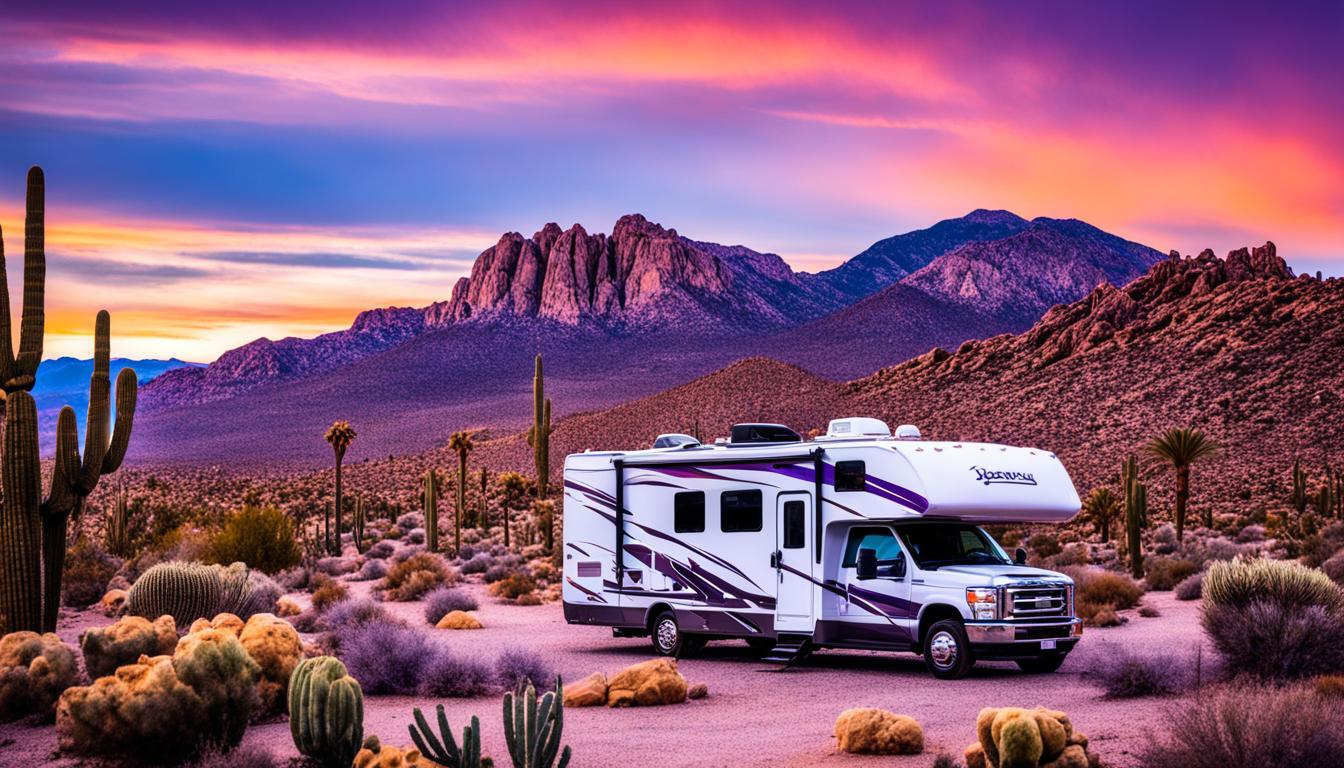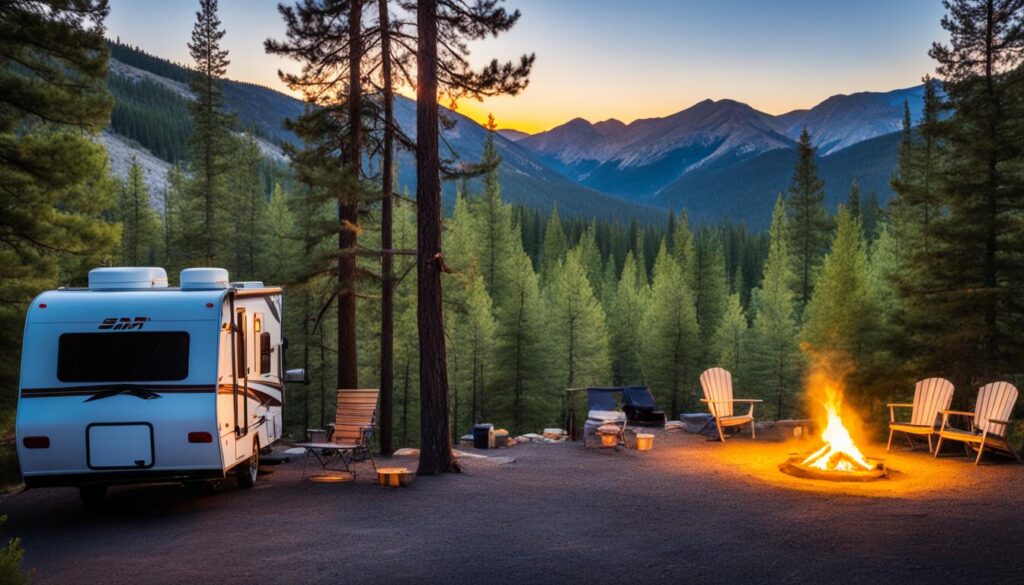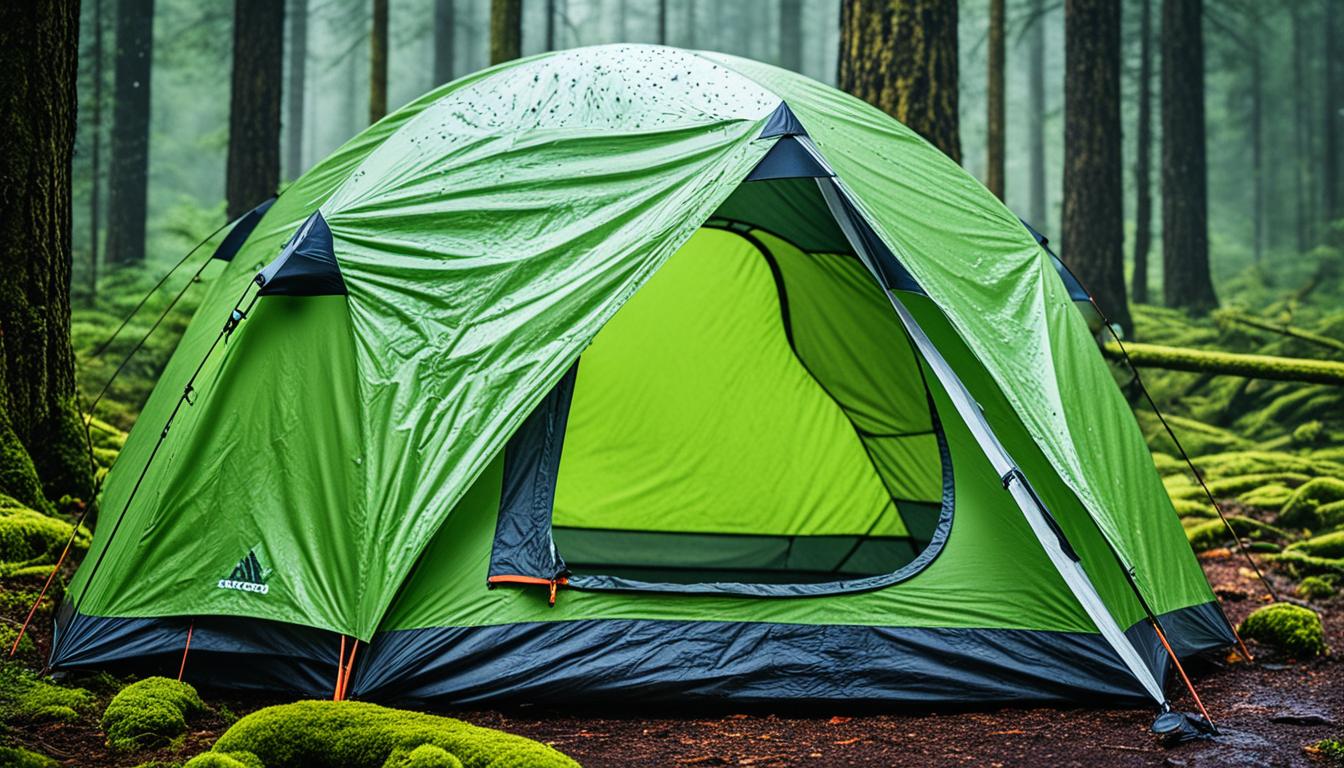
For outdoor fans like me, camping is a thrilling way to get closer to nature. There’s a rich variety of camping types, from full-service camps in national parks to self-sufficient boondocking journeys. Each offers its unique adventure. This piece will look into boondocking and regular camping, making it easier to choose what suits your style.
Understanding Boondocking and Camping
When talking about outdoor fun, people often mix up “boondocking” and “camping.” Yet, they mean different things. Boondocking is popular with RV fans. It means camping in an RV without usual campsite comforts like power and water hookups. Traditional camping, on the other hand, means using a tent or RV in a campground with basics and services.
Defining Boondocking
Boondocking is also called dry or off-grid camping. It’s about camping in the wild, away from campgrounds. Boondockers are ready for this. They bring their water, power, and waste needs. This way, they can be close to nature without crowded campsites.
Defining Traditional Camping
Traditional camping is more about structure. It’s setting up in campgrounds with some comforts. These places are often in nature parks or areas just for camping. They have bathrooms, water, and maybe power. This makes it easier to enjoy the great outdoors.
| Boondocking | Traditional Camping |
|---|---|
| Camping in a self-contained RV or vehicle on public lands or remote areas | Setting up a tent or RV in a designated campground with access to basic facilities and services |
| No access to traditional campground amenities like electricity, water, or sewage hookups | Campgrounds provide access to restrooms, running water, and sometimes electricity |
| Requires self-sufficiency and preparation | Offers a more structured and managed outdoor experience |
| Allows for a deeper immersion in nature and off-grid living | Provides the convenience of campground amenities |
The Allure of Boondocking
Boondocking is appealing because it offers freedom and adventure. You camp in beautiful, off-the-beaten-path spots. This is away from the packed campgrounds, letting you connect deeper with nature.
Choosing your own spot to camp is a big plus of boondocking. You’re not limited to cramped campgrounds. You can enjoy serene lakes or rugged mountains away from the usual crowds.
Boondocking lets you live off-the-grid. It means no modern distractions. This quiet time can be refreshing for reconnecting with nature and yourself.
Boondocking is cheaper than staying at campgrounds. You save money as you enjoy nature. It’s great for those watching their budget or wanting to visit distant areas.
In the end, boondocking’s charm is in its freedom, adventure, and nature connection. Whether for a peaceful break or a budget-friendly adventure, boondocking is a special experience.
What Is the Difference Between Boondocking and Camping?
Boondocking and traditional camping provide unique experiences for nature lovers. The biggest differences are in where you stay, what you have, and the costs. Also, there’s a difference in permits.
Location and Amenities
Boondocking is a type of free camping. It’s often done on lands like national forests or BLM areas. These places might not have common campground features, like water or bathrooms.
On the other hand, traditional campgrounds are in specific spots in parks or on private lands. They offer more, like running water and restrooms.
Cost and Permits
Boondocking is usually cheaper than traditional camping. You may camp for free on public lands or pay a small fee. But, you usually have to pay to camp in normal campgrounds. You might also need to reserve a spot beforehand.
When it comes to permits, you might not need one for boondocking, but for campgrounds, you usually do.
| Feature | Boondocking | Traditional Camping |
|---|---|---|
| Location | Public lands (national forests, BLM areas) | Designated campgrounds (national/state parks, private sites) |
| Amenities | Limited or no access to utilities, restrooms, and other facilities | Access to utilities, restrooms, and other basic amenities |
| Cost | Free or low-cost | Fees for overnight stays, often with required reservations |
| Permits | May not require a permit, depending on location | Permits often required |
Knowing the differences helps outdoor fans choose the best option for them. They can consider their budget, what they want in a camping trip, and the available choices.
The Boondocking Experience
Setting off on a boondocking adventure is truly unique. It’s far from your usual camping trip. To really enjoy boondocking, you have to be all about self-sufficiency. And feel a deep connection with the nature around you.
Preparation and Self-Sufficiency
Boondocking means you need more prep than a regular campground visit. Boondockers bring their own water, power, and ways to handle waste. This makes it possible for them to live comfortably off the grid. They don’t depend on outside help for a good time.
- Make sure you have plenty of water for drinking, cooking, and staying clean
- Get a strong power setup, like solar panels or a generator, for your tech needs
- Figure out how you’re going to deal with waste, both gray water and human waste
- Bring along the right camping gear, like a cozy place to sleep and cooking stuff
Connecting with Nature
Boondockers really love how this type of camping lets them be in nature. By stepping away from modern life, they dive into the peace and beauty around them. This break from daily noise brings a calm feeling and a great love for the outdoors.
The boondocking experience is often seen as a mix of adventure and peace. Because there’s no set camping area, boondockers get to see special places. And they get lost in the quiet harmony of nature.
Best Practices for Boondocking
Boondocking is a unique way to camp off-grid. It allows freedom and closeness to nature. But, it’s important to camp responsibly. We must keep the environment clean and respect others. Following these rules helps us keep boondocking spots beautiful for future campers.
Choose your boondocking spots wisely. Look for places that welcome boondockers. You can also check with the authorities or online for good spots. Don’t camp where it might harm the environment.
“Leave no trace” is key in boondocking. This means taking all trash with you. Also, don’t bring in plants or animals. And, minimize any harm to the land. Always dispose of waste correctly according to local rules.
- Carefully select your boondocking site to minimize impact on the environment.
- Practice “leave no trace” principles by packing out all your trash and disposing of waste properly.
- Be respectful of other campers and the natural surroundings, keeping noise and disturbances to a minimum.
- Adhere to any local regulations or guidelines regarding boondocking, such as length of stay or permitted activities.
- Maintain a small campfire, if permitted, and extinguish it completely before departing.
Treating others and the environment with respect is also crucial. Keep quiet during set quiet hours. Know and follow local rules like how long you can stay or what you can do there. This makes sure everyone enjoys the boondocking experience.
Following these tips makes your boondocking journey great. You also help protect nature. As caring boondockers, we keep places green and welcoming. This is our duty for enjoying off-grid camping and leaving good memories.
Camping vs. Boondocking: The Pros and Cons
When you think about RV travel, you face the choice between traditional camping and boondocking. Each has its own good and bad points. Knowing these can help you decide what’s best for you.
Pros of Boondocking
Boondocking offers a sense of freedom and adventure. You camp in nature without amenities. This off-the-grid life is usually free or cheap.
It lets you be more flexible with your RV travels. You’re not tied to set campsites or schedules. You can find secluded, scenic spots that big RVs can’t reach. Boondocking is all about a custom adventure.
Cons of Boondocking
But, boondocking has its challenges. You need to be self-sufficient because utilities are scarce. Planning and having special equipment are key.
It might not suit those looking for a comfy, social camping trip. And you might need to spend more time driving to find spots. This can use more fuel and stress your RV.

On the other hand, camping is more structured and has facilities like bathrooms. It can feel like a big community, with people doing things together. But it can be costly and crowded.
In the end, picking between boondocking and traditional camping is all about what you prefer and your plans. Know the ups and downs of each to have a great RV experience and memories.
Conclusion
The main differences between boondocking and traditional camping are in the spot, what’s there, and the whole adventure. Boondocking is for those who love being far away, doing things themselves, and saving money. If you like being with other campers and using camp facilities, traditional camping is for you. Each style offers its own kind of fun. So, picking the best one depends on what kind of trip you’re looking for and how you like to camp.
Are you into the excitement of RV adventures or the calm of tent camping? Or maybe you dream of living off the grid? Which one you choose affects your camping time a lot. From being alone in the wild to enjoying campgrounds, both have good points and things to think about. It’s important to know what you like and what’s important to you when you’re picking a way to camp.
Would you like to explore the wild parts of national parks or feel closer to nature? Choosing boondocking or traditional camping really changes your camping story. Knowing about each kind helps you have a great time that matches your love for adventure, independence, and being close to nature.
FAQ
What is the difference between boondocking and camping?
Boondocking and traditional camping differ in location and amenities. Boondocking happens on public lands where you’re allowed to camp but without facilities. On the other hand, traditional campgrounds provide facilities and are often found in national parks or privately owned sites.
What is boondocking?
Boondocking means camping in an RV or vehicle without hookups. This is done in remote places or on public lands. It offers a unique camping experience, away from typical amenities.
What is traditional camping?
Setting up a tent or RV in a place with basic facilities is traditional camping. You might find such sites in many campgrounds that are officially designated.
What are the benefits of boondocking?
Boondocking offers freedom and adventure. You get to camp in beautiful, quiet places away from everyone. It’s cheaper than traditional camping and lets you connect with nature more deeply.
What do I need to prepare for boondocking?
Preparing for boondocking is key to enjoying it. You need your own water, power, and waste solutions. This prepares you to enjoy nature in its pure form.
What are the best practices for responsible boondocking?
It’s crucial to boondock responsibly. This involves picking the right spots, not leaving a trace, and properly managing waste. Doing so helps keep these beautiful spots accessible for others.
What are the pros and cons of boondocking compared to traditional camping?
Both boondocking and traditional camping have their own good and bad points. Boondocking is great for saving money and being closer to nature but requires more preparation. Traditional camping offers more comfort and community but can be expensive and less private.
- Discover the 4 Must-Have Camping Tent Accessories for Spring 2025 - March 19, 2025
- Why Camping Is Bad - November 29, 2024
- Best Camping Knife - November 29, 2024






